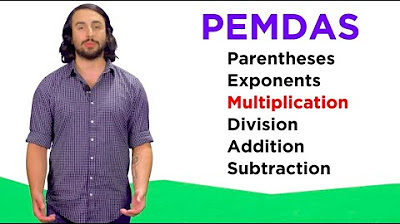Your Daily Equation #22: 8 - 2 ÷ 2 x 3 + 4 = ?
TLDRIn this episode of 'Your Daily Equation,' the host discusses the issue of ambiguity in mathematical expressions and the reliance on the PEMDAS rule in education. The host argues that math should be about understanding patterns and using precise language, rather than memorizing arbitrary rules. They advocate for teaching students the importance of order of operations with a few examples and then emphasizing the clarity of mathematical sentences through parentheses, which professionals use instead of PEMDAS. The episode calls for a shift in math education to focus on the beauty and wonder of math, beyond rote learning.
Takeaways
- 😀 The speaker is addressing an issue in math education that they find irritating, specifically the ambiguity in arithmetic problems due to the order of operations.
- 🤔 The episode focuses on the importance of the order of operations in mathematics and how different interpretations can lead to different answers.
- 📚 The acronym PEMDAS is introduced as a common rule taught in schools to determine the order of operations, which stands for Parentheses, Exponents, Multiplication and Division (from left to right), and Addition and Subtraction (from left to right).
- 🧐 The speaker expresses their personal experience as a professional physicist, stating they have not used PEMDAS in their career and prefers clear mathematical sentences using parentheses.
- 😡 The speaker is critical of the emphasis on PEMDAS in schools, suggesting it teaches students that math is about applying arbitrary rules rather than understanding patterns.
- 👨🏫 The speaker suggests that teaching PEMDAS may give students the wrong impression about the nature of mathematics, focusing on rules rather than the beauty and patterns of math.
- 📝 The speaker advocates for the use of parentheses to clarify the intended order of operations in mathematical expressions, rather than relying on the PEMDAS rule.
- 🔑 The episode highlights the importance of precision in mathematical communication, especially in professional settings where ambiguity is not acceptable.
- 💡 The speaker proposes an alternative approach to teaching order of operations, suggesting that students should be shown the importance of clarity and then move on to explore the beauty of mathematics.
- 🤖 The speaker acknowledges that computer programmers might have a different perspective on the use of such rules, as they can make code more efficient.
- 🗣️ The speaker invites feedback from the audience, asking if they have a different view on the use of PEMDAS in their work or analysis.
Q & A
What is the main topic of the episode of 'Your Daily Equation' discussed in the transcript?
-The main topic is the issue of order of operations in math education and the reliance on the acronym PEMDAS to interpret mathematical sentences.
What does the acronym PEMDAS stand for and what is its purpose?
-PEMDAS stands for Parentheses, Exponents, Multiplication and Division (from left to right), Addition and Subtraction (from left to right). It is a rule used to determine the order of operations in mathematical expressions.
Why does the speaker find the reliance on PEMDAS problematic in math education?
-The speaker finds it problematic because it can lead to a misunderstanding that math is about applying arbitrary rules rather than focusing on the beauty and patterns encapsulated in precise mathematical sentences.
What does the speaker suggest as an alternative to teaching PEMDAS?
-The speaker suggests teaching students the importance of the order of operations with a few examples and then emphasizing the use of parentheses to make mathematical sentences clear and precise.
How does the speaker feel about the way his daughter's school is teaching math, specifically the concept of order of operations?
-The speaker feels dejected and irritated because the teaching method focuses on applying arbitrary rules like PEMDAS, which he believes detracts from the beauty and patterns of math.
What does the speaker believe is the essence of math according to the transcript?
-The speaker believes that the essence of math is the wondrous patterns and universal truths that can be encapsulated with precise mathematical sentences, not the application of arbitrary rules.
How does the speaker describe the use of parentheses in professional mathematical communication?
-The speaker describes the use of parentheses as a way to make the order of operations in a mathematical sentence clear and precise, eliminating ambiguity and the need for acronyms like PEMDAS.
What is the speaker's opinion on the duration and method of teaching the PEMDAS rule in schools?
-The speaker believes that the time spent teaching PEMDAS, possibly weeks, is excessive and that the focus on 'gotcha' problems can lead to students viewing math as a series of tricks rather than a discipline based on patterns and precision.
Why does the speaker think that the use of parentheses is more effective than PEMDAS in mathematical communication?
-The speaker thinks that parentheses are more effective because they provide a clear and unambiguous way to indicate the intended order of operations, which is essential for precise mathematical communication.
What is the speaker's advice for students learning math?
-The speaker advises students to understand the importance of the order of operations but to focus more on using parentheses to clarify their mathematical sentences, rather than relying on acronyms like PEMDAS.
How does the speaker view the potential impact of teaching methods on students' perception of math?
-The speaker views the teaching methods that emphasize arbitrary rules over patterns and precision as potentially harmful, as they can lead to a distorted perception of math as a discipline of drudgery rather than one of beauty and wonder.
Outlines
😤 Order of Operations Controversy
The speaker begins by expressing frustration with a common issue in math education, specifically the ambiguity that arises from the lack of clear order of operations in arithmetic problems. They use a simple arithmetic example to illustrate how different interpretations can lead to different answers, emphasizing the importance of the order of operations. The speaker also introduces the acronym PEMDAS, which is taught in schools to determine the order of operations, and shares their view that it's an arbitrary rule that doesn't reflect the precision required in professional mathematical communication.
🧐 The Futility of PEMDAS in Professional Math
Continuing the discussion, the speaker, a professional physicist, argues that in over thirty years, they have never used PEMDAS in their career. They criticize the teaching method that focuses on this acronym, suggesting it promotes an understanding of math as a set of arbitrary rules rather than a language for expressing precise ideas. The speaker advocates for the use of parentheses to explicitly define the order of operations, which they believe is a more professional and clear approach. They express disappointment in the way math education can sometimes fail to convey the beauty and patterns of mathematics.
🌟 The Beauty of Precise Mathematical Communication
In the final paragraph, the speaker emphasizes the beauty of mathematics, which they believe lies in its ability to encapsulate universal patterns with precision. They propose an alternative approach to teaching the order of operations, suggesting that after a few examples to understand the concept, students should be taught to use parentheses to clarify their mathematical expressions. The speaker argues against the overemphasis on rules like PEMDAS and encourages focusing on the elegance and power of mathematical patterns. They conclude by inviting feedback from the audience, asking whether they use PEMDAS in their work and seeking diverse perspectives on the issue.
Mindmap
Keywords
💡Order of Operations
💡PEMDAS
💡Ambiguity
💡Parentheses
💡Math Education
💡Professional Physicist
💡Arbitrary Rules
💡Patterns
💡Beauty of Math
💡Graduate Student
💡Code
Highlights
The speaker introduces the topic of math pedagogy and the issue of ambiguous arithmetic problems.
The importance of the order of operations in determining the correct answer to an arithmetic problem is emphasized.
The concept of PEMDAS is introduced as a rule for order of operations but is critiqued as arbitrary.
The speaker argues that the use of parentheses is a more precise method than relying on PEMDAS.
Examples are given to illustrate how different interpretations of an equation can lead to different answers.
The speaker expresses frustration with the focus on rules like PEMDAS in math education.
The idea that math should be about understanding patterns and not just applying rules is presented.
The speaker's personal experience as a professional physicist is shared, noting the lack of use for PEMDAS in professional settings.
A critique of math education for teaching ambiguous mathematical sentences and reliance on PEMDAS.
The speaker suggests that math education should focus on the beauty and patterns of math rather than on rules.
The notion that math is about precise mathematical sentences is emphasized over arbitrary rules.
The speaker's daughter's experience with learning PEMDAS in school is shared as an example of the current state of math education.
The potential negative impact of teaching PEMDAS on students' perception of math is discussed.
The speaker advocates for a change in math education to focus on clarity and precision in mathematical expressions.
An alternative approach to teaching order of operations using parentheses instead of acronyms is suggested.
The speaker invites feedback and different perspectives on the use of PEMDAS and math education practices.
The episode concludes with a reiteration of the importance of patterns and precision in mathematics.
Transcripts
Browse More Related Video
5.0 / 5 (0 votes)
Thanks for rating:





